Analytical Methods for Engineers: Algebraic Methods TMA 1 (v2.1)
VerifiedAdded on 2023/06/03
|15
|1679
|243
Homework Assignment
AI Summary
This document presents a solved assignment for the 'Analytical Methods for Engineers' module, focusing on algebraic methods. It includes detailed solutions to five questions covering topics such as transposing formulas, solving equations using logarithms, finding values in given equations, polynomial long division, and applying quadratic formulas to solve problems related to motion and geometric progressions. The assignment provides step-by-step explanations and calculations, making it a valuable resource for students studying similar concepts. This solved assignment is available on Desklib, a platform offering a wide range of study tools and resources for students.
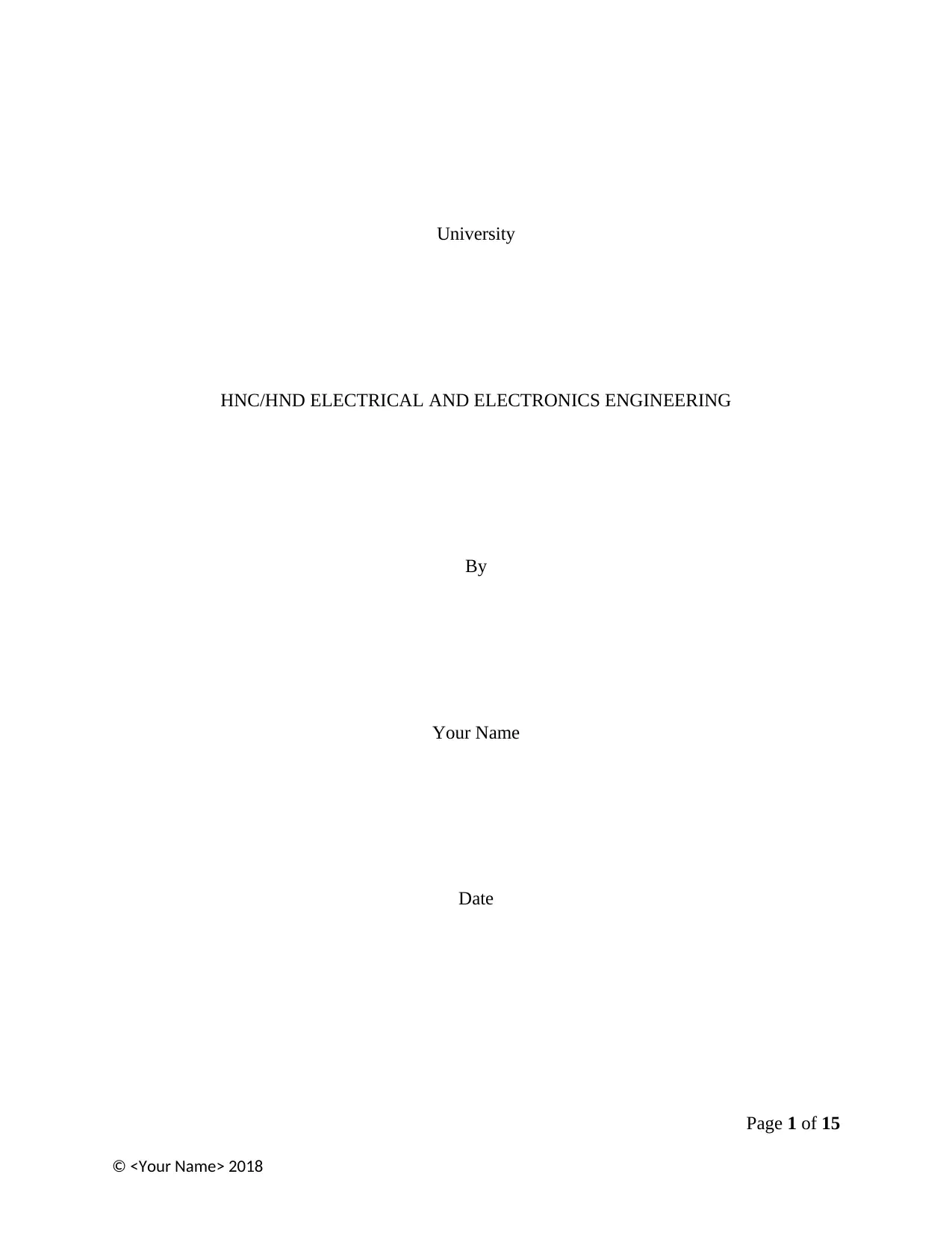
University
HNC/HND ELECTRICAL AND ELECTRONICS ENGINEERING
By
Your Name
Date
Page 1 of 15
© <Your Name> 2018
HNC/HND ELECTRICAL AND ELECTRONICS ENGINEERING
By
Your Name
Date
Page 1 of 15
© <Your Name> 2018
Paraphrase This Document
Need a fresh take? Get an instant paraphrase of this document with our AI Paraphraser
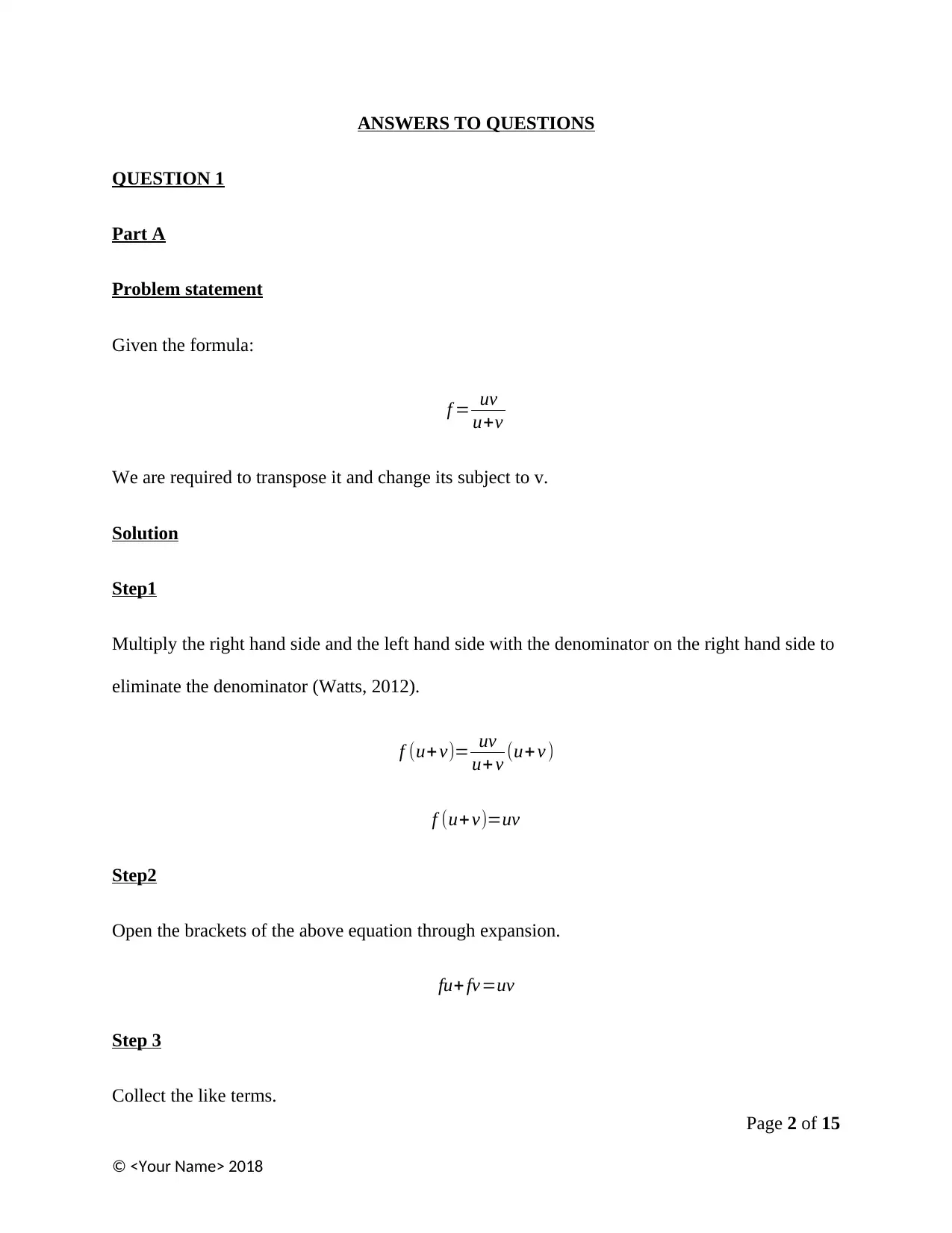
ANSWERS TO QUESTIONS
QUESTION 1
Part A
Problem statement
Given the formula:
f = uv
u+v
We are required to transpose it and change its subject to v.
Solution
Step1
Multiply the right hand side and the left hand side with the denominator on the right hand side to
eliminate the denominator (Watts, 2012).
f (u+ v)= uv
u+ v (u+ v )
f (u+ v)=uv
Step2
Open the brackets of the above equation through expansion.
fu+ fv=uv
Step 3
Collect the like terms.
Page 2 of 15
© <Your Name> 2018
QUESTION 1
Part A
Problem statement
Given the formula:
f = uv
u+v
We are required to transpose it and change its subject to v.
Solution
Step1
Multiply the right hand side and the left hand side with the denominator on the right hand side to
eliminate the denominator (Watts, 2012).
f (u+ v)= uv
u+ v (u+ v )
f (u+ v)=uv
Step2
Open the brackets of the above equation through expansion.
fu+ fv=uv
Step 3
Collect the like terms.
Page 2 of 15
© <Your Name> 2018
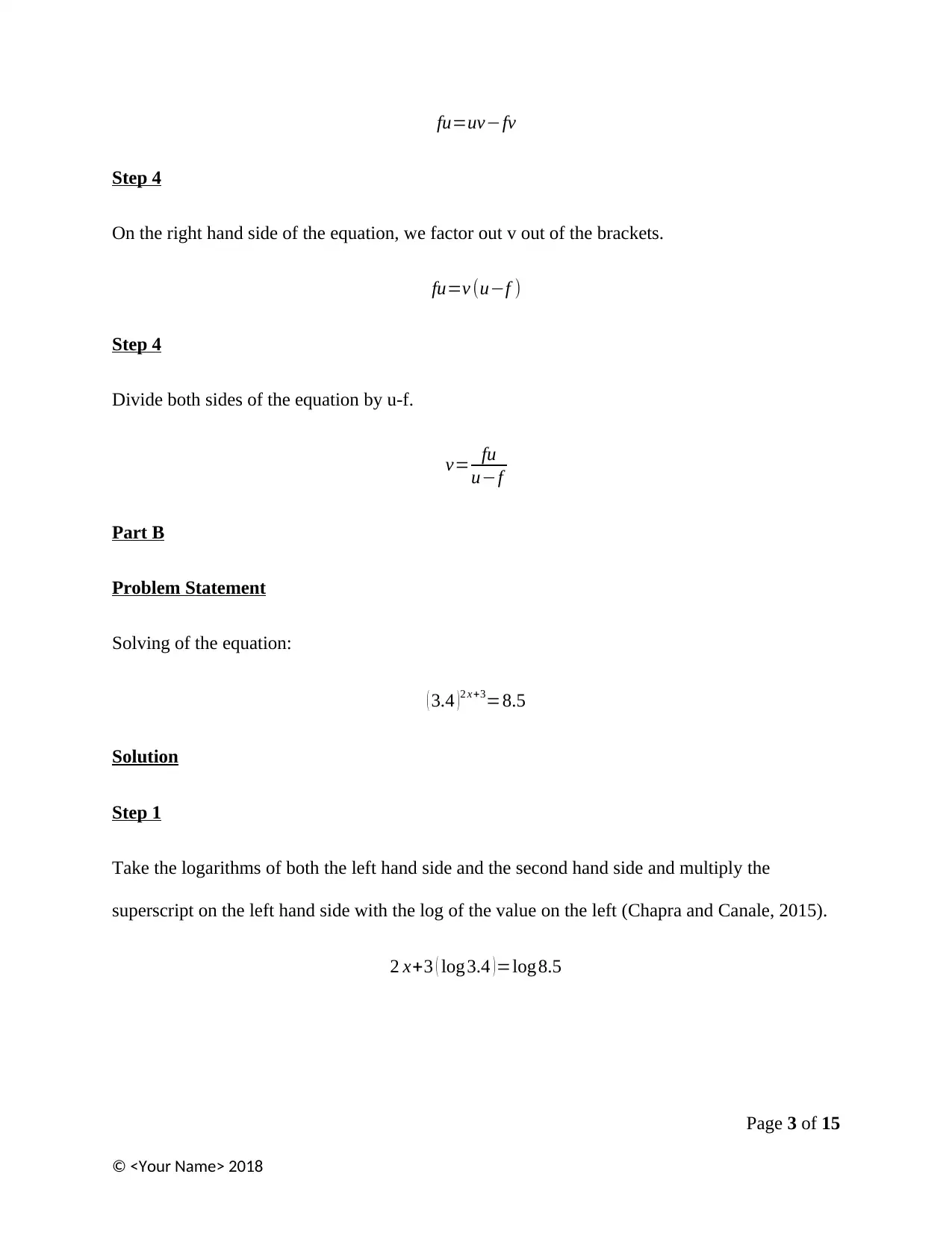
fu=uv−fv
Step 4
On the right hand side of the equation, we factor out v out of the brackets.
fu=v (u−f )
Step 4
Divide both sides of the equation by u-f.
v= fu
u−f
Part B
Problem Statement
Solving of the equation:
( 3.4 ) 2 x+3=8.5
Solution
Step 1
Take the logarithms of both the left hand side and the second hand side and multiply the
superscript on the left hand side with the log of the value on the left (Chapra and Canale, 2015).
2 x+3 ( log3.4 ) =log8.5
Page 3 of 15
© <Your Name> 2018
Step 4
On the right hand side of the equation, we factor out v out of the brackets.
fu=v (u−f )
Step 4
Divide both sides of the equation by u-f.
v= fu
u−f
Part B
Problem Statement
Solving of the equation:
( 3.4 ) 2 x+3=8.5
Solution
Step 1
Take the logarithms of both the left hand side and the second hand side and multiply the
superscript on the left hand side with the log of the value on the left (Chapra and Canale, 2015).
2 x+3 ( log3.4 ) =log8.5
Page 3 of 15
© <Your Name> 2018
⊘ This is a preview!⊘
Do you want full access?
Subscribe today to unlock all pages.

Trusted by 1+ million students worldwide
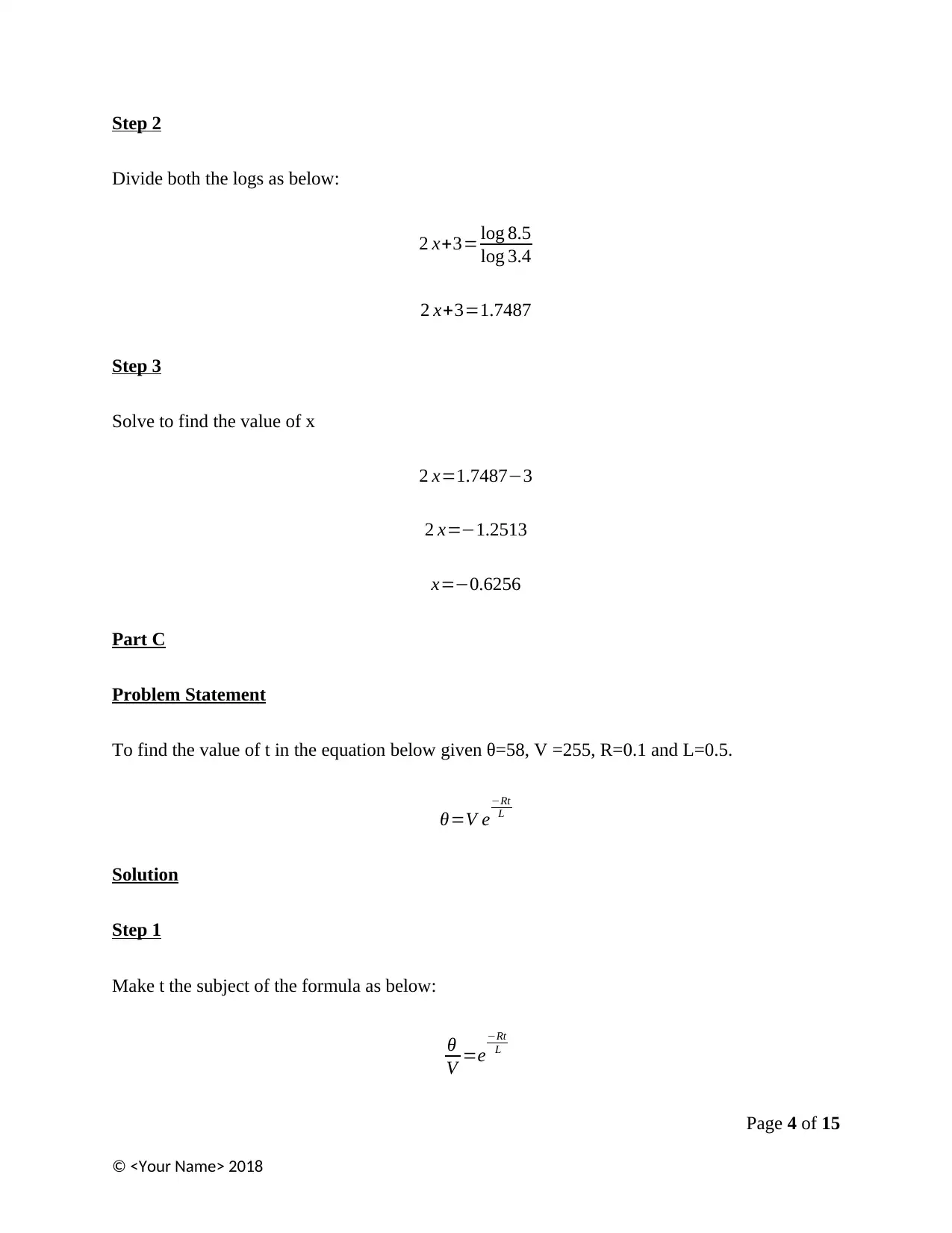
Step 2
Divide both the logs as below:
2 x+3= log 8.5
log 3.4
2 x+3=1.7487
Step 3
Solve to find the value of x
2 x=1.7487−3
2 x=−1.2513
x=−0.6256
Part C
Problem Statement
To find the value of t in the equation below given θ=58, V =255, R=0.1 and L=0.5.
θ=V e
−Rt
L
Solution
Step 1
Make t the subject of the formula as below:
θ
V =e
−Rt
L
Page 4 of 15
© <Your Name> 2018
Divide both the logs as below:
2 x+3= log 8.5
log 3.4
2 x+3=1.7487
Step 3
Solve to find the value of x
2 x=1.7487−3
2 x=−1.2513
x=−0.6256
Part C
Problem Statement
To find the value of t in the equation below given θ=58, V =255, R=0.1 and L=0.5.
θ=V e
−Rt
L
Solution
Step 1
Make t the subject of the formula as below:
θ
V =e
−Rt
L
Page 4 of 15
© <Your Name> 2018
Paraphrase This Document
Need a fresh take? Get an instant paraphrase of this document with our AI Paraphraser
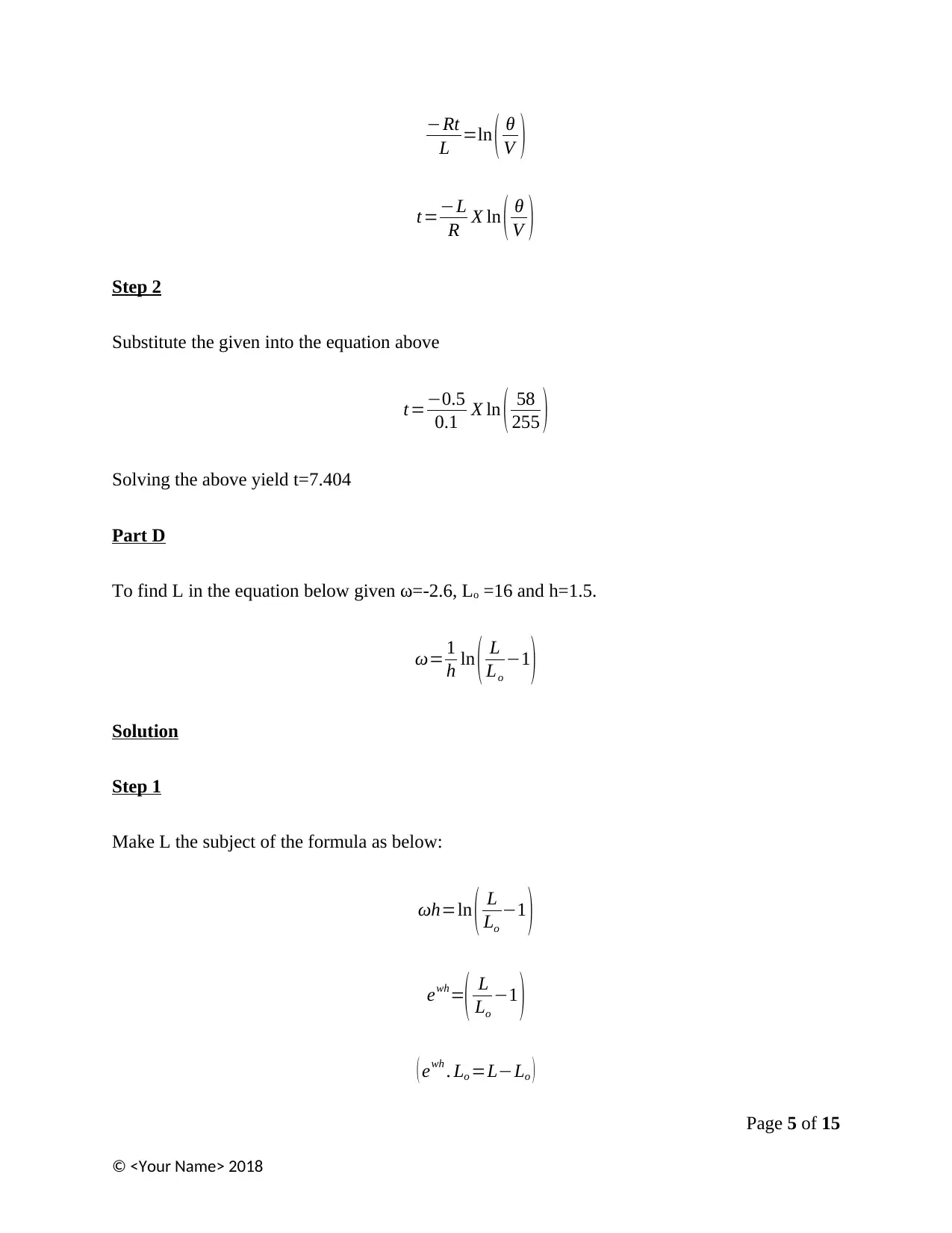
−Rt
L =ln ( θ
V )
t=−L
R X ln ( θ
V )
Step 2
Substitute the given into the equation above
t=−0.5
0.1 X ln ( 58
255 )
Solving the above yield t=7.404
Part D
To find L in the equation below given ω=-2.6, Lo =16 and h=1.5.
ω= 1
h ln ( L
Lo
−1
)
Solution
Step 1
Make L the subject of the formula as below:
ωh=ln ( L
Lo
−1 )
ewh=( L
Lo
−1 )
( ewh . Lo =L−Lo )
Page 5 of 15
© <Your Name> 2018
L =ln ( θ
V )
t=−L
R X ln ( θ
V )
Step 2
Substitute the given into the equation above
t=−0.5
0.1 X ln ( 58
255 )
Solving the above yield t=7.404
Part D
To find L in the equation below given ω=-2.6, Lo =16 and h=1.5.
ω= 1
h ln ( L
Lo
−1
)
Solution
Step 1
Make L the subject of the formula as below:
ωh=ln ( L
Lo
−1 )
ewh=( L
Lo
−1 )
( ewh . Lo =L−Lo )
Page 5 of 15
© <Your Name> 2018
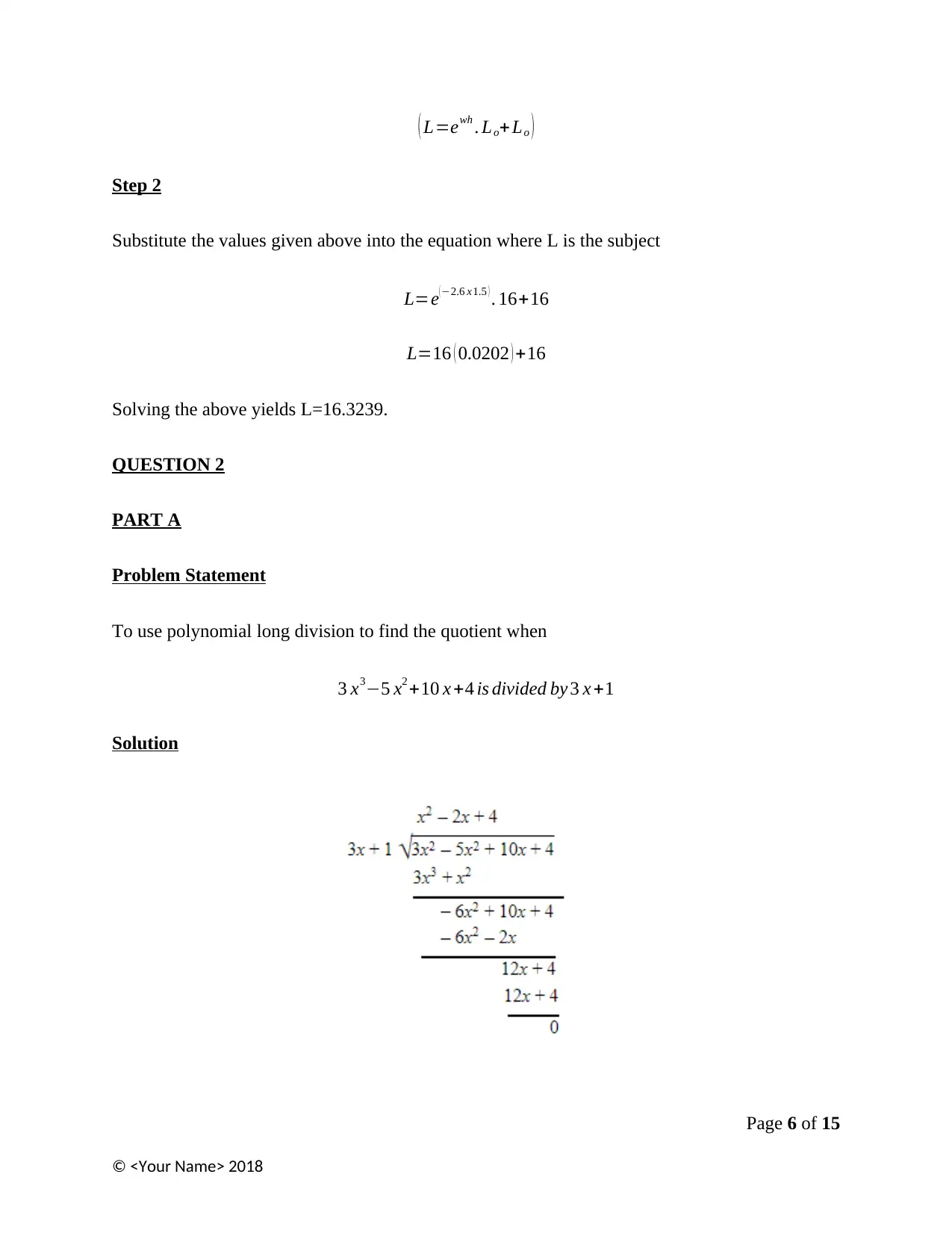
( L=ewh . Lo+Lo )
Step 2
Substitute the values given above into the equation where L is the subject
L=e
(−2.6 x1.5 ) . 16+16
L=16 ( 0.0202 ) +16
Solving the above yields L=16.3239.
QUESTION 2
PART A
Problem Statement
To use polynomial long division to find the quotient when
3 x3−5 x2 +10 x +4 is divided by 3 x +1
Solution
Page 6 of 15
© <Your Name> 2018
Step 2
Substitute the values given above into the equation where L is the subject
L=e
(−2.6 x1.5 ) . 16+16
L=16 ( 0.0202 ) +16
Solving the above yields L=16.3239.
QUESTION 2
PART A
Problem Statement
To use polynomial long division to find the quotient when
3 x3−5 x2 +10 x +4 is divided by 3 x +1
Solution
Page 6 of 15
© <Your Name> 2018
⊘ This is a preview!⊘
Do you want full access?
Subscribe today to unlock all pages.

Trusted by 1+ million students worldwide

Hence the quotient is x2−2 x+ 4
Page 7 of 15
© <Your Name> 2018
Page 7 of 15
© <Your Name> 2018
Paraphrase This Document
Need a fresh take? Get an instant paraphrase of this document with our AI Paraphraser
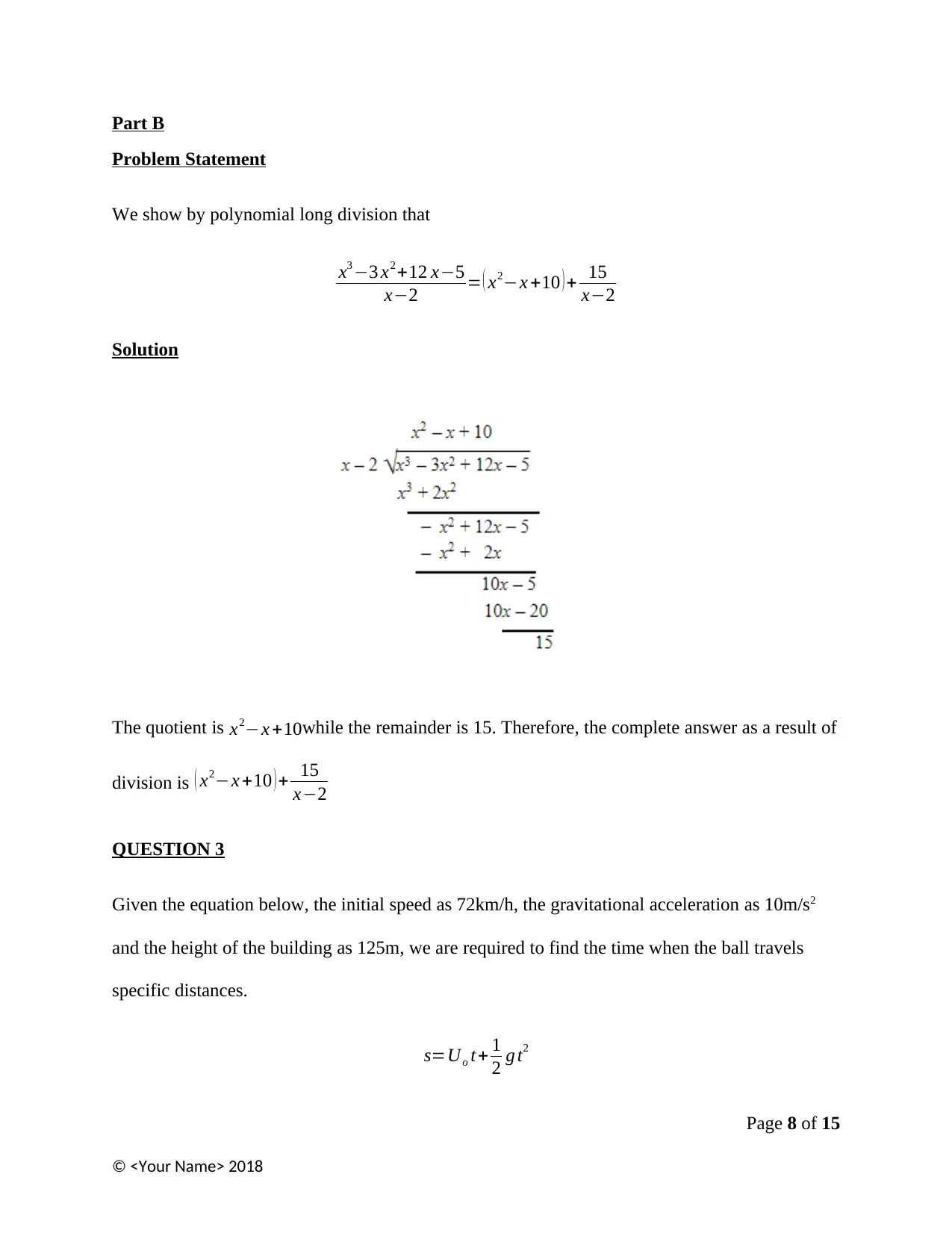
Part B
Problem Statement
We show by polynomial long division that
x3 −3 x2 +12 x−5
x−2 = ( x2−x +10 ) + 15
x−2
Solution
The quotient is x2−x +10while the remainder is 15. Therefore, the complete answer as a result of
division is ( x2−x +10 ) + 15
x−2
QUESTION 3
Given the equation below, the initial speed as 72km/h, the gravitational acceleration as 10m/s2
and the height of the building as 125m, we are required to find the time when the ball travels
specific distances.
s=Uo t+ 1
2 g t2
Page 8 of 15
© <Your Name> 2018
Problem Statement
We show by polynomial long division that
x3 −3 x2 +12 x−5
x−2 = ( x2−x +10 ) + 15
x−2
Solution
The quotient is x2−x +10while the remainder is 15. Therefore, the complete answer as a result of
division is ( x2−x +10 ) + 15
x−2
QUESTION 3
Given the equation below, the initial speed as 72km/h, the gravitational acceleration as 10m/s2
and the height of the building as 125m, we are required to find the time when the ball travels
specific distances.
s=Uo t+ 1
2 g t2
Page 8 of 15
© <Your Name> 2018
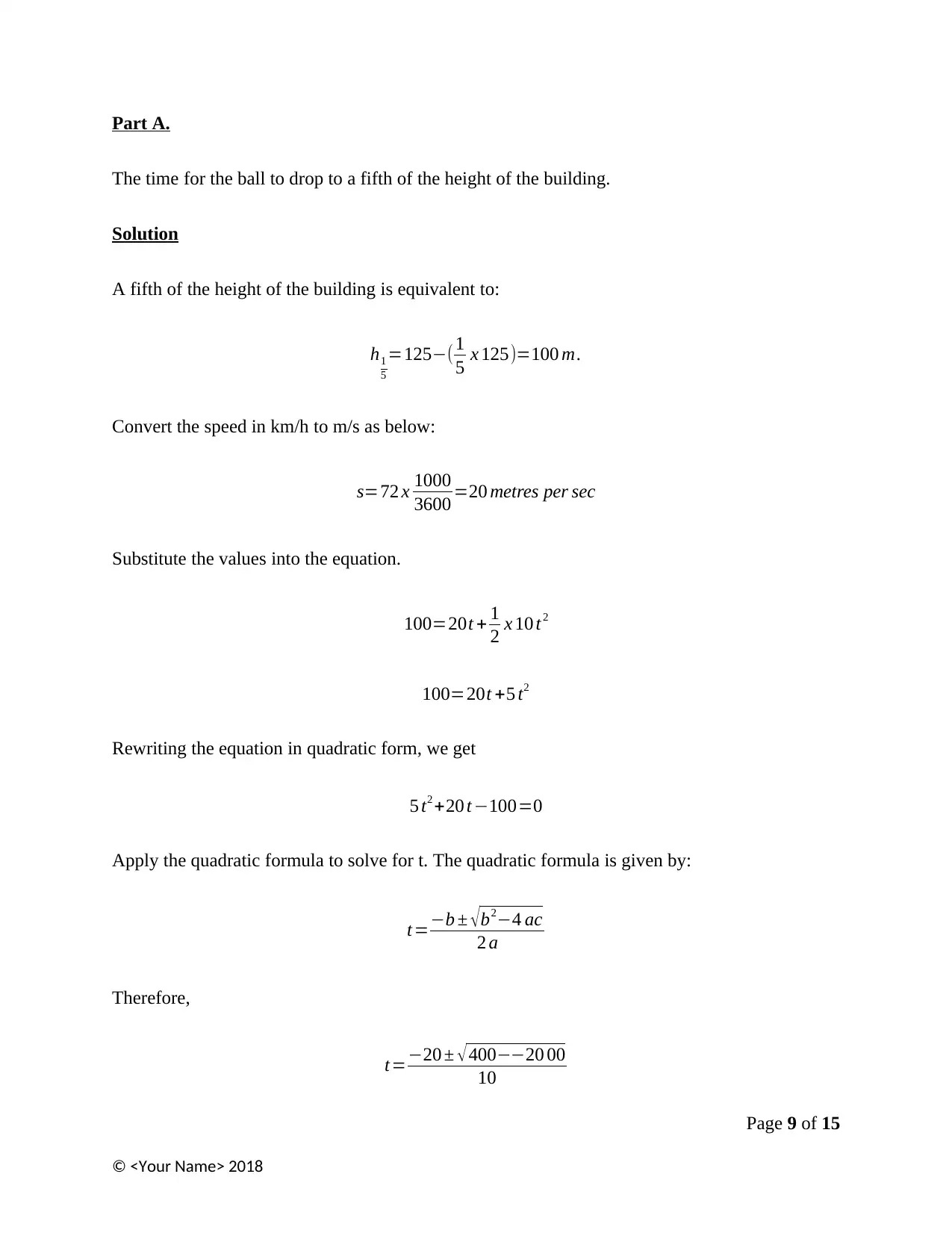
Part A.
The time for the ball to drop to a fifth of the height of the building.
Solution
A fifth of the height of the building is equivalent to:
h1
5
=125−(1
5 x 125)=100 m.
Convert the speed in km/h to m/s as below:
s=72 x 1000
3600 =20 metres per sec
Substitute the values into the equation.
100=20t + 1
2 x 10 t2
100=20t +5 t2
Rewriting the equation in quadratic form, we get
5 t2 +20 t −100=0
Apply the quadratic formula to solve for t. The quadratic formula is given by:
t=−b ± √b2−4 ac
2 a
Therefore,
t=−20 ± √400−−20 00
10
Page 9 of 15
© <Your Name> 2018
The time for the ball to drop to a fifth of the height of the building.
Solution
A fifth of the height of the building is equivalent to:
h1
5
=125−(1
5 x 125)=100 m.
Convert the speed in km/h to m/s as below:
s=72 x 1000
3600 =20 metres per sec
Substitute the values into the equation.
100=20t + 1
2 x 10 t2
100=20t +5 t2
Rewriting the equation in quadratic form, we get
5 t2 +20 t −100=0
Apply the quadratic formula to solve for t. The quadratic formula is given by:
t=−b ± √b2−4 ac
2 a
Therefore,
t=−20 ± √400−−20 00
10
Page 9 of 15
© <Your Name> 2018
⊘ This is a preview!⊘
Do you want full access?
Subscribe today to unlock all pages.

Trusted by 1+ million students worldwide
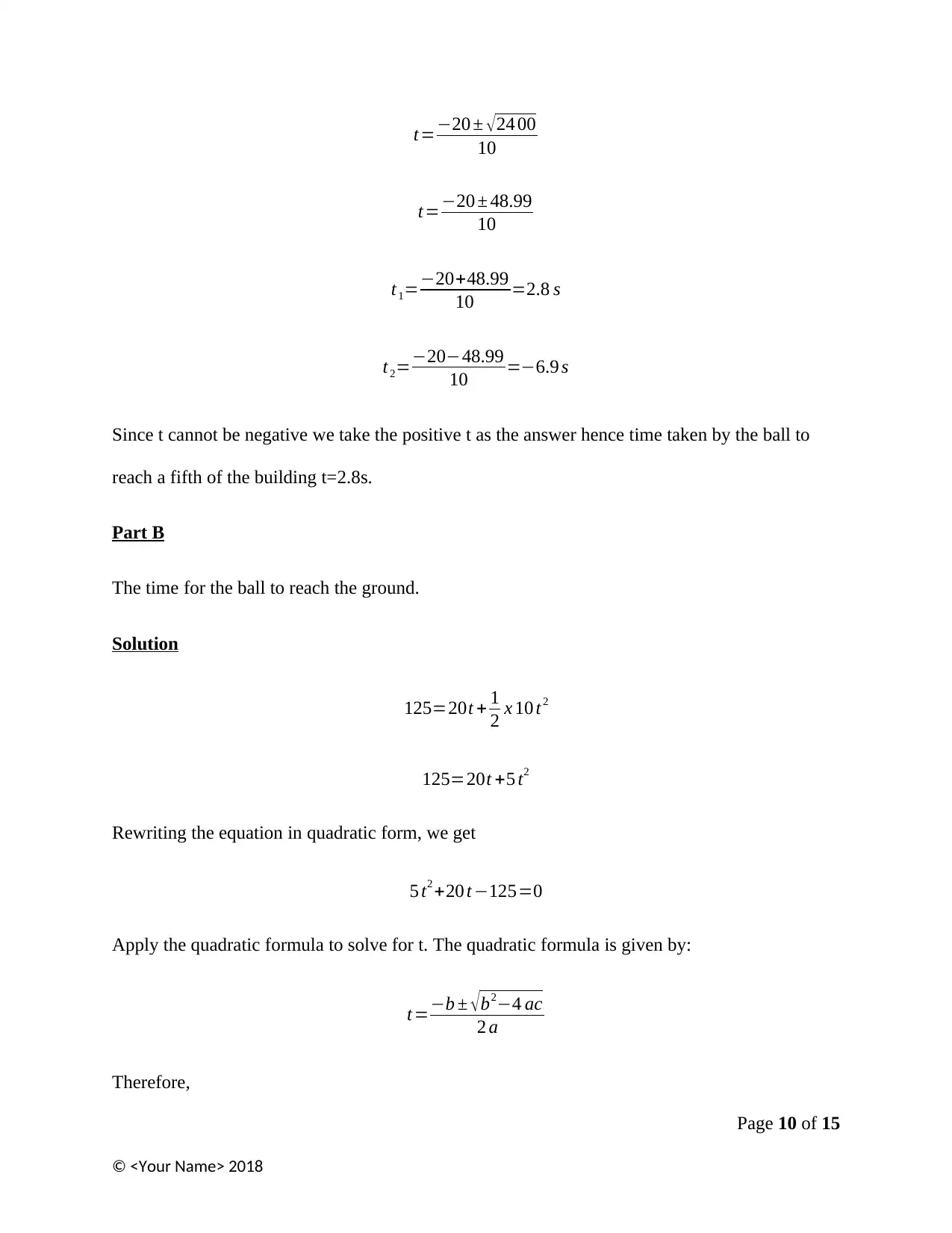
t=−20 ± √24 00
10
t=−20 ± 48.99
10
t1=−20+48.99
10 =2.8 s
t2=−20−48.99
10 =−6.9 s
Since t cannot be negative we take the positive t as the answer hence time taken by the ball to
reach a fifth of the building t=2.8s.
Part B
The time for the ball to reach the ground.
Solution
125=20t + 1
2 x 10 t2
125=20t +5 t2
Rewriting the equation in quadratic form, we get
5 t2 +20 t −125=0
Apply the quadratic formula to solve for t. The quadratic formula is given by:
t=−b ± √b2−4 ac
2 a
Therefore,
Page 10 of 15
© <Your Name> 2018
10
t=−20 ± 48.99
10
t1=−20+48.99
10 =2.8 s
t2=−20−48.99
10 =−6.9 s
Since t cannot be negative we take the positive t as the answer hence time taken by the ball to
reach a fifth of the building t=2.8s.
Part B
The time for the ball to reach the ground.
Solution
125=20t + 1
2 x 10 t2
125=20t +5 t2
Rewriting the equation in quadratic form, we get
5 t2 +20 t −125=0
Apply the quadratic formula to solve for t. The quadratic formula is given by:
t=−b ± √b2−4 ac
2 a
Therefore,
Page 10 of 15
© <Your Name> 2018
Paraphrase This Document
Need a fresh take? Get an instant paraphrase of this document with our AI Paraphraser
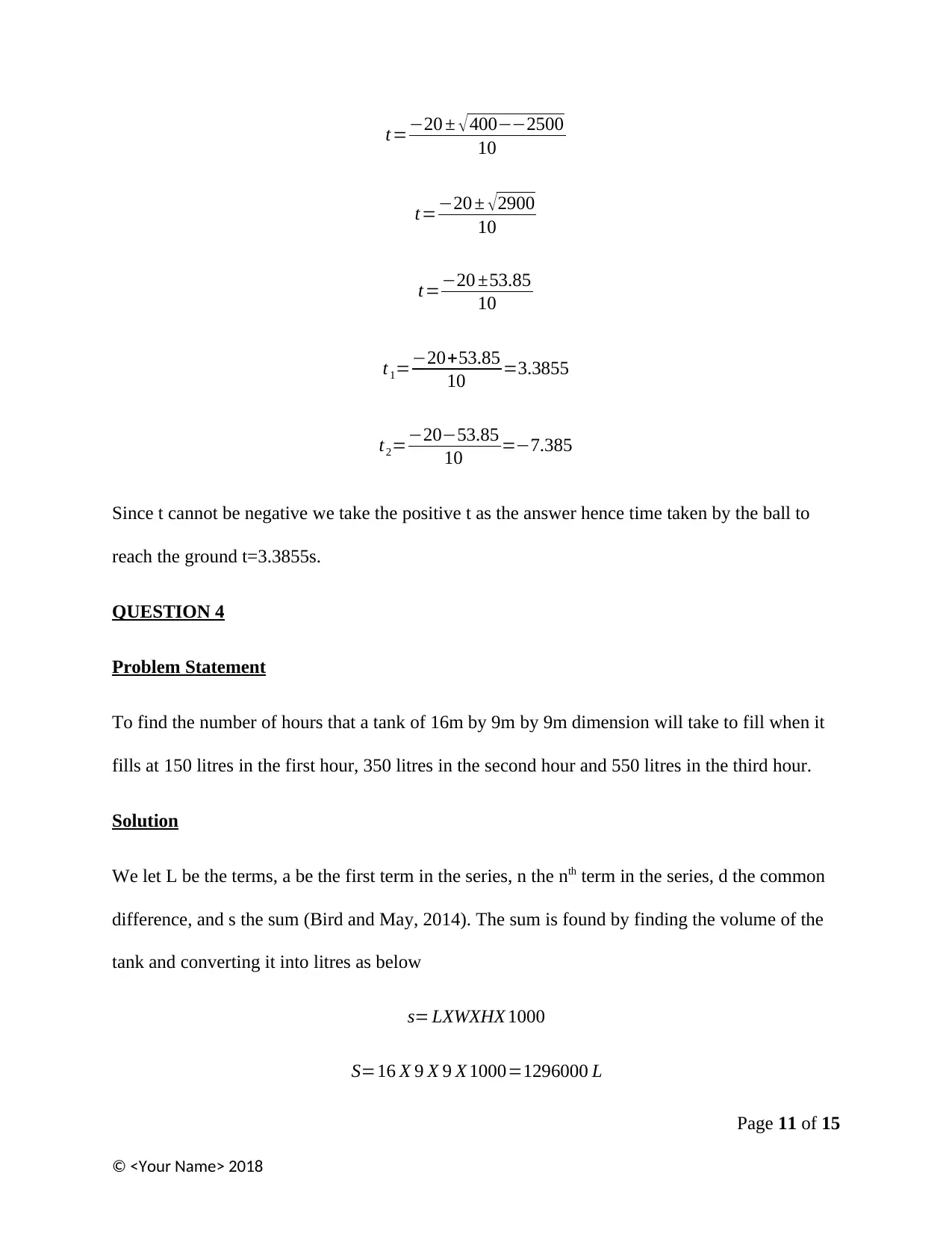
t=−20 ± √400−−2500
10
t=−20 ± √2900
10
t=−20 ±53.85
10
t1=−20+53.85
10 =3.3855
t2=−20−53.85
10 =−7.385
Since t cannot be negative we take the positive t as the answer hence time taken by the ball to
reach the ground t=3.3855s.
QUESTION 4
Problem Statement
To find the number of hours that a tank of 16m by 9m by 9m dimension will take to fill when it
fills at 150 litres in the first hour, 350 litres in the second hour and 550 litres in the third hour.
Solution
We let L be the terms, a be the first term in the series, n the nth term in the series, d the common
difference, and s the sum (Bird and May, 2014). The sum is found by finding the volume of the
tank and converting it into litres as below
s= LXWXHX 1000
S=16 X 9 X 9 X 1000=1296000 L
Page 11 of 15
© <Your Name> 2018
10
t=−20 ± √2900
10
t=−20 ±53.85
10
t1=−20+53.85
10 =3.3855
t2=−20−53.85
10 =−7.385
Since t cannot be negative we take the positive t as the answer hence time taken by the ball to
reach the ground t=3.3855s.
QUESTION 4
Problem Statement
To find the number of hours that a tank of 16m by 9m by 9m dimension will take to fill when it
fills at 150 litres in the first hour, 350 litres in the second hour and 550 litres in the third hour.
Solution
We let L be the terms, a be the first term in the series, n the nth term in the series, d the common
difference, and s the sum (Bird and May, 2014). The sum is found by finding the volume of the
tank and converting it into litres as below
s= LXWXHX 1000
S=16 X 9 X 9 X 1000=1296000 L
Page 11 of 15
© <Your Name> 2018
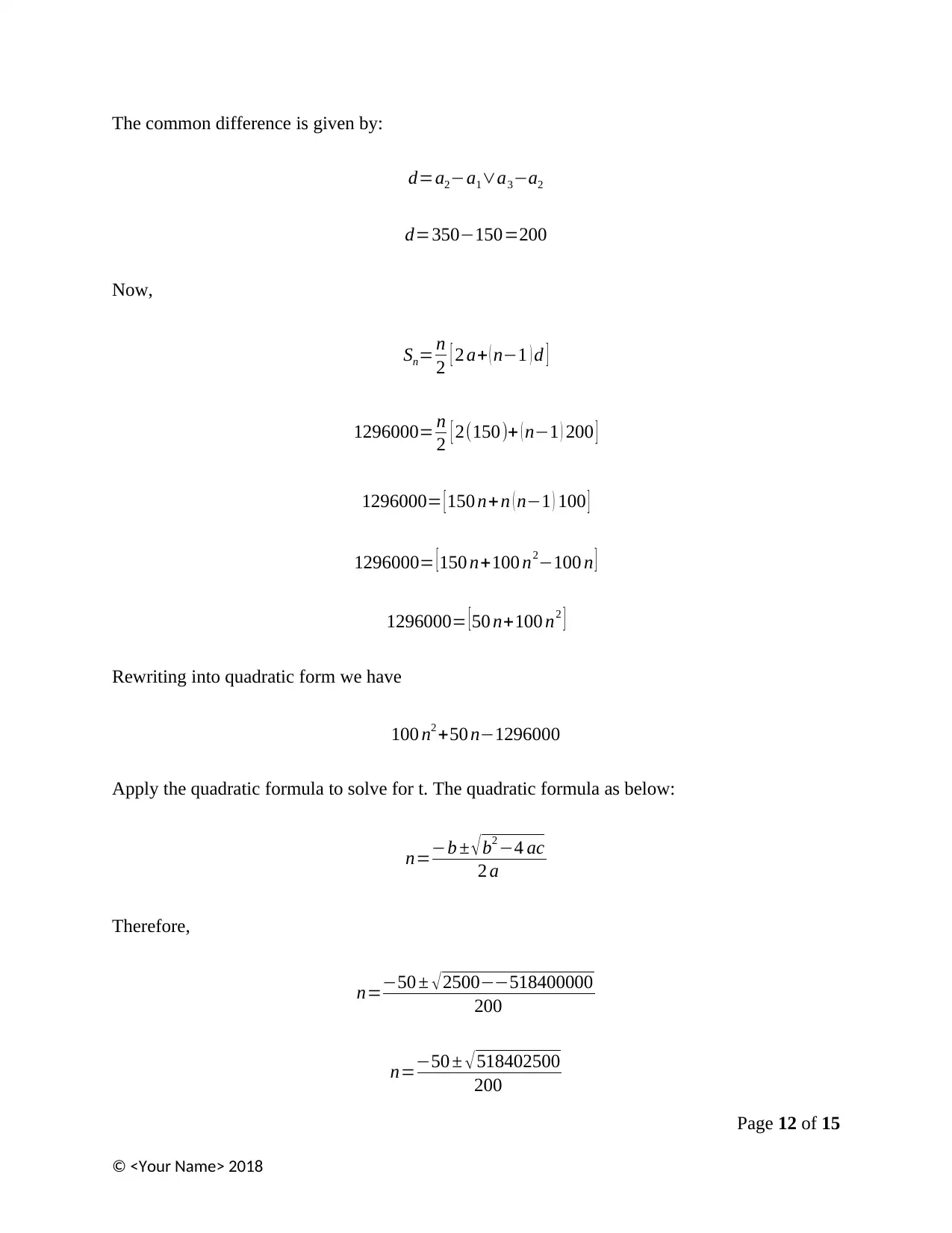
The common difference is given by:
d=a2−a1∨a3−a2
d=350−150=200
Now,
Sn= n
2 [ 2 a+ ( n−1 ) d ]
1296000= n
2 [ 2(150)+ ( n−1 ) 200 ]
1296000= [ 150 n+n ( n−1 ) 100 ]
1296000= [150 n+100 n2−100 n ]
1296000= [50 n+100 n2 ]
Rewriting into quadratic form we have
100 n2 +50 n−1296000
Apply the quadratic formula to solve for t. The quadratic formula as below:
n=−b ± √b2 −4 ac
2 a
Therefore,
n=−50 ± √2500−−518400000
200
n=−50 ± √ 518402500
200
Page 12 of 15
© <Your Name> 2018
d=a2−a1∨a3−a2
d=350−150=200
Now,
Sn= n
2 [ 2 a+ ( n−1 ) d ]
1296000= n
2 [ 2(150)+ ( n−1 ) 200 ]
1296000= [ 150 n+n ( n−1 ) 100 ]
1296000= [150 n+100 n2−100 n ]
1296000= [50 n+100 n2 ]
Rewriting into quadratic form we have
100 n2 +50 n−1296000
Apply the quadratic formula to solve for t. The quadratic formula as below:
n=−b ± √b2 −4 ac
2 a
Therefore,
n=−50 ± √2500−−518400000
200
n=−50 ± √ 518402500
200
Page 12 of 15
© <Your Name> 2018
⊘ This is a preview!⊘
Do you want full access?
Subscribe today to unlock all pages.

Trusted by 1+ million students worldwide
1 out of 15
Your All-in-One AI-Powered Toolkit for Academic Success.
+13062052269
info@desklib.com
Available 24*7 on WhatsApp / Email
![[object Object]](/_next/static/media/star-bottom.7253800d.svg)
Unlock your academic potential
Copyright © 2020–2025 A2Z Services. All Rights Reserved. Developed and managed by ZUCOL.
